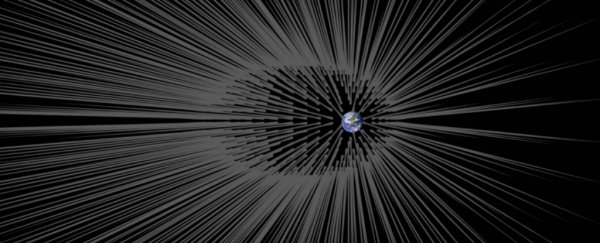Scientists have spent decades trying to detect dark matter throughout the Universe, but now calculations by a NASA scientist suggest that our planet might have been surrounded by the mysterious particles this whole time, in the form of long, invisible filaments, or 'hairs', stretching away from Earth's surface.
It sounds like a pretty out-there idea, but the hypothesis is founded on solid calculations, and, if confirmed, could finally help scientists to directly detect hidden dark matter – which makes up 27 percent of all matter and energy in the Universe – for the first time.
We know that dark matter exists because scientists are able to measure its gravitational pull on other objects in the Universe, but the reason no one has been able to detect it is because it's totally invisible, and doesn't absorb or reflect light.
Previous research has suggested that dark matter tends to pool in streams of particles that move at the same velocity and steadily orbit galaxies, such as our own.
"A stream can be much larger than the solar system itself, and there are many different streams crisscrossing our galactic neighbourhood," said physicist Gary Prézeau, from NASA's Jet Propulsion Laboratory.
So if that's the case, Prézeau wondered, what happens when dark matter approaches a planet like Earth? Regular matter obviously would bounce right off the surface of a planet, but dark matter has the handy feature of not interacting with normal matter at all, so it can travel through Earth like a ghost.
But using computer simulations, Prézeau's was able to show that our planet would still have some effect on dark matter – the calculations revealed that as the dark matter streams pass through a planet, the planet's gravity would focus and bend the streams until they form long, narrow, and dense hair-like filaments. These hairs would bend and kink in response to the density in each planet.
What's most fascinating is that the calculations revealed certain areas along these filaments where dark matter is particularly concentrated, which you can think of as the 'root' of the hair.
This root would occur around 1 million kilometres (600,000 miles) from Earth's surface, which is about twice as far as the Moon, and in that area Prézeau predicts that the density of dark matter particles would be about 1 billion times more than the rest of the stream.
For dark matter passing through giant Jupiter, the root of dark matter would be almost 1 trillion times denser than average, which is pretty mind-blowing. The research will be published this week in the Astrophysical Journal.
Further study is now needed to back up this hypothesis – after all, we're only going off one set of computer simulations here. But if we find more evidence that these hairs really do stretch out from planets in our Solar System, it means we'll have a pretty good idea of where to look for dark matter next.
"If we could pinpoint the location of the root of these hairs, we could potentially send a probe there and get a bonanza of data about dark matter," said Prézeau.
Exciting times.
